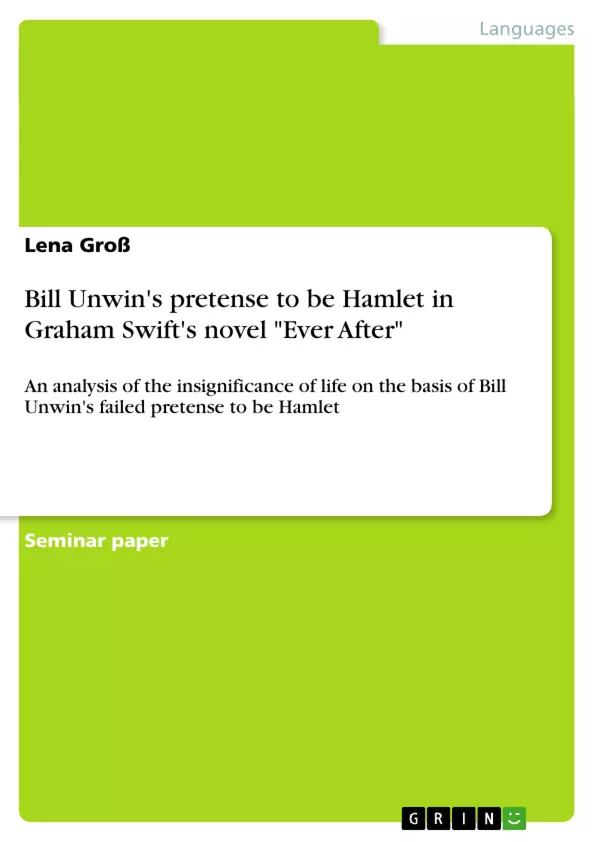“I am who I am. I am Bill Unwin (there, I declare myself!). I am Hamlet the
Dane” (Swift 173). This citation neatly covers what Graham Swift’s novel Ever
After is about; a no one identifies himself with a world-famous figure, namely William Shakespeare’s Hamlet, to provide some structure and meaning to his irrelevant existence.
Swift tries to picture the insignificance of life and therefore, focuses the
story of this middle-aged desperate and childless widower Bill Unwin, who recently survived an attempted suicide. Searching for clues to understand his life, Unwin addresses themes such as love, loss, identity, mortality, and the ephemeral nature of life. In order to give his own existence a sense of meaning, Bill empathizes with Hamlet, but in the end the reader has to discover that these two characters have nothing in common and Unwin’s emptiness of life is stressed. So, if you take all of Unwin’s façade and shape away he tried to construct from Hamlet, no meaning to his life, rather nothing remains, thus,
this novel is to show how meaningless and transient life actually is.
Therefore, to illustrate this occurrence in this paper, first of all, shared character traits between Bill Unwin and Hamlet the Dane are listed to later on destroy the illusion of Bill being Hamlet by outlining the differences between these two figures. Following, the emptiness of Unwin’s life is pointed out and reasons of creating the protagonist like this are specified. Finally, Swift’s intention is reached as the overall insignificance of life becomes obvious.
Inhaltsverzeichnis (Table of Contents)
- Insignificance of Life
- Bill Unwin's Pretense to Be Hamlet
- Shared Character Traits
- Differences between These Figures
- Swift's Intention to Chose Hamlet as a Reference Text and to Create His Narrator like This
- A Story for Reflection.......
Zielsetzung und Themenschwerpunkte (Objectives and Key Themes)
This novel focuses on the life of Bill Unwin, a middle-aged widower struggling with the meaninglessness of his existence. He attempts to find solace and identity by identifying himself with Hamlet, but ultimately his efforts reveal the emptiness of his life.
- The insignificance and transience of life
- The search for meaning and identity
- The relationship between love, loss, and grief
- The theme of revenge and the impossibility of achieving it
- The power of literary references and intertextuality
Zusammenfassung der Kapitel (Chapter Summaries)
The first chapter introduces Bill Unwin, a character deeply impacted by his father's suicide and his subsequent marriage to his stepmother, Sam. He draws parallels between himself and Hamlet, attempting to find meaning in this comparison. The second chapter explores the shared character traits between Bill and Hamlet, focusing on themes of vengeance, meditation, and the search for meaning. This chapter also highlights the significant differences between the two characters, particularly in terms of their personalities and their roles in society. The third chapter delves into Bill's relationship with his stepfather, Sam, and his attempt to frame him as a villainous figure like Claudius. However, it ultimately reveals the inherent flaws in this comparison, suggesting that Bill's identification with Hamlet is a desperate attempt to find meaning in a life he perceives as empty.
Schlüsselwörter (Keywords)
This novel explores themes of meaninglessness, identity, and the search for purpose. It centers around the complex relationship between Bill Unwin and Hamlet, analyzing the similarities and differences between these two characters. The use of literary references, particularly to Shakespeare's Hamlet, is a key element of the work. Themes of love, loss, and revenge are woven into the narrative, ultimately highlighting the transient and insignificant nature of life.
- Quote paper
- Lena Groß (Author), 2013, Bill Unwin's pretense to be Hamlet in Graham Swift's novel "Ever After", Munich, GRIN Verlag, https://www.grin.com/document/269075



